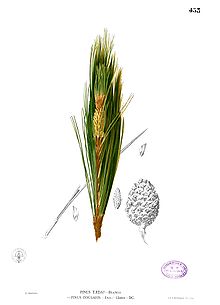bio.wikisort.org - Plant
Pinus kesiya (Khasi pine, Benguet pine or three-needled pine) is one of the most widely distributed pines in Asia. Its range extends south and east from the Khasi Hills in the northeast Indian state of Meghalaya, to northern Thailand, Philippines, Burma, Cambodia, Laos, southernmost China, and Vietnam. It is an important plantation species elsewhere in the world, including in southern Africa and South America.[2][3]
The common name "Khasi pine" is from the Khasi hills in India, and "Benguet pine" is from the landlocked province of Benguet in Luzon, Philippines, where it is the dominant species of the Luzon tropical pine forests. The Benguet pine is sometimes treated as a separate species, Pinus insularis; however, the current opinion is to treat these as conspecific with P. kesiya. The city of Baguio is nicknamed "The City of Pines", as it is noted for large stands of this tree.
Description

Pinus kesiya is a tree reaching up to 30–35 metres (98–115 feet) tall with a straight, cylindrical trunk. The bark is thick and dark brown, with deep longitudinal fissures. The branches are robust, red brown from the second year, the branchlets horizontal to drooping. The leaves are needle-like, dark green, usually 3 per fascicle, 15–20 centimetres (6–8 inches) long, the fascicle sheath 1–2 cm (1⁄2–3⁄4 in) long and persistent. The cones are ovoid, 5–9 cm (2–3+1⁄2 in) long, often curved downwards, sometimes slightly distorted; the scales of second-year cones are dense, the umbo a little convex, sometimes acutely spinous. The scales have transverse and longitudinal ridges across the middle of the scale surface. The seeds are winged, 6–7 millimetres (1⁄4–9⁄32 in) long with a 1.5–2.5 cm wing. Pollination occurs in mid-spring, with the cones maturing 18–20 months after.[citation needed]
Khasi pine usually grows in pure stands or mixed with broad-leaved trees, but does not form open pine forests.[citation needed]
Uses
The soft and light timber of Pinus kesiya can be used for a wide range of applications, including boxes, paper pulp, and temporary electric poles. It is intensely used for timber, both sourced in natural forests and plantations.[2][3]
The good-quality resin is not abundant and has not been much used except during the Spanish colonial period in the Philippines for the production of turpentine.[citation needed]
See also
- Casuarina equisetifolia, the agoho pine
References
- Farjon, A. (2013). "Pinus kesiya". IUCN Red List of Threatened Species. 2013: e.T42372A2975925. doi:10.2305/IUCN.UK.2013-1.RLTS.T42372A2975925.en. Retrieved 19 November 2021.
- Luu, Nguyen Duc To; Philip Ian Thomas (2004). Conifers of Vietnam. pp. 42–43. ISBN 1-872291-64-3. Archived from the original on 2007-05-19.
- "Pinus kesiya". AgroForestryTree Database. International Centre for Research in Agroforestry. Retrieved 17 April 2012.
External links
| Wikimedia Commons has media related to Pinus kesiya. |
- Gymnosperm Database: Pinus kesiya
- Suitability of Pinus kesiya for tree-ring analyses
- "Luzon Tropical Forests". Terrestrial Ecoregions. World Wildlife Fund.
На других языках
[de] Pinus kesiya
Pinus kesiya ist eine Pflanzenart aus der Gattung der Kiefern (Pinus) innerhalb der Familie der Kieferngewächse (Pinaceae). Das Verbreitungsgebiet liegt in China, Indien, auf den Philippinen und in Indochina. Es werden zwei Varietäten unterschieden. Sie ist ein wichtiger Holzlieferant Südostasiens und wird auch in anderen Ländern in Afrika, Südamerika und Australien aus forstwirtschaftlichen Gründen gepflanzt.- [en] Pinus kesiya
[fr] Pinus kesiya
Pinus insularis • Pin de Benguet, Pin à trois aiguilles[ru] Сосна островная
Сосна островная, или хазийская, или кезия (лат. Pinus kesiya) — вид вечнозелёных хвойных деревьев рода Сосна, один из наиболее широко распространённых видов сосен Юго-Восточной Азии.Другой контент может иметь иную лицензию. Перед использованием материалов сайта WikiSort.org внимательно изучите правила лицензирования конкретных элементов наполнения сайта.
WikiSort.org - проект по пересортировке и дополнению контента Википедии


